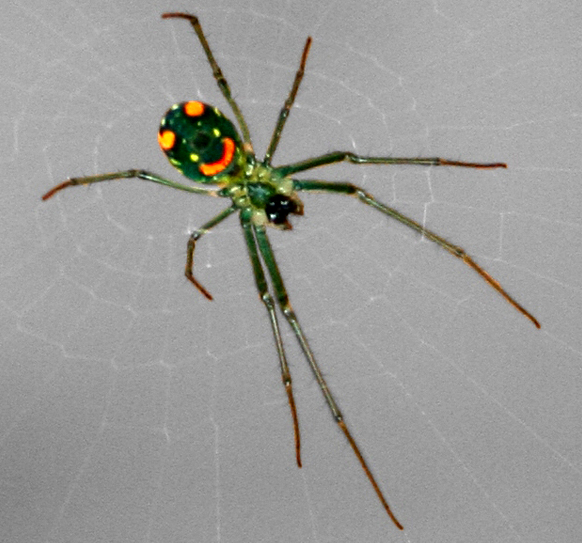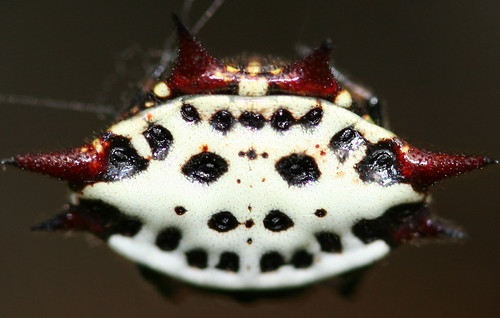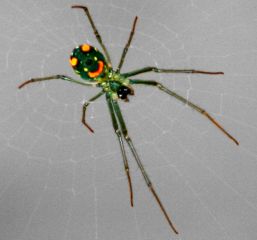Top 7 Smiling Spider List
The Top 7 Smiling Spider List And Other Cool Faces
We have compiled a list of the top smiling spiders known online and some that you may not know of already. These guys are from all over the world and have been published on major sites simply because of one thing: They make us smile. We never thought a list could be compiled of the smiling spider, but we found out, we wrong. What's amazing is that they contain symbols of laughter more than any other "bug" that we know of. We use the word "bug" even though they are technically arachnids. Besides all the above, the coolest thing is that these spiders have the biggest smiles (with more species involved) than any other bug. Smiling spiders are weird to some because most people don't usually think of spiders as a positive thing. However, the spider family is very beneficial to us and the ecosystem. That's why we're writing this article, and that's to remind you that spiders are not all that bad. Yes, there are some spiders with different amounts of toxicity within their bites, but being bitten is rare compared to other numbers such as mosquitoes (which more people die from). That's why we think the focus shouldn't be as negative as they are today. Just from personal experience, I've been bit/stung by more centipedes, wasp, ants, and mosquitoes than spiders (if ever). So while on that note, let's go ahead and view the list of the Top 7 Smiling Spiders And Other Cool Faces.
They're color is also very cheery and can bring some color around the home when you find them. Not like the widow family, you'll find them out in the open with nothing to hide. They're very quick and shy when you get close. They'll more likely hide to spare their life. So don't worry about any kind of danger from these guys.
2. Spinybacked Orbweaver Spider
The Goldenrod Crab spider gets its name due to its major hunting among the goldenrod flowers. It hunts mainly in the autumn and blends quite well with at this time among these flowers. Since the goldenrod flowers attract many bugs, it makes a great place to hunt for large insects. This is perfect for the females who need more food while trying to lay eggs. These spiders also have the ability into changing colors by secreting liquid into the outer cell of their body. By doing this, it gives them another advantage when hunting among white flowers.
We have compiled a list of the top smiling spiders known online and some that you may not know of already. These guys are from all over the world and have been published on major sites simply because of one thing: They make us smile. We never thought a list could be compiled of the smiling spider, but we found out, we wrong. What's amazing is that they contain symbols of laughter more than any other "bug" that we know of. We use the word "bug" even though they are technically arachnids. Besides all the above, the coolest thing is that these spiders have the biggest smiles (with more species involved) than any other bug. Smiling spiders are weird to some because most people don't usually think of spiders as a positive thing. However, the spider family is very beneficial to us and the ecosystem. That's why we're writing this article, and that's to remind you that spiders are not all that bad. Yes, there are some spiders with different amounts of toxicity within their bites, but being bitten is rare compared to other numbers such as mosquitoes (which more people die from). That's why we think the focus shouldn't be as negative as they are today. Just from personal experience, I've been bit/stung by more centipedes, wasp, ants, and mosquitoes than spiders (if ever). So while on that note, let's go ahead and view the list of the Top 7 Smiling Spiders And Other Cool Faces.
The Smiling Spider List Begins...
1. Venusta Orchard Spider

Taxonomy
Chelicerata » Arachnida » Araneae » Araneomorphae » Entelegynes » Long-jawed Tetragnathidae » Leucauge » Leucauge venustaAbout the Venusta Orchard Spider
They are green with bright orangish red markings that appear to be a smile at a certain angle. These guys are mistaken for the widow family. Biggest way to differentiate between the two is by looking at the markings. The widow family will have an hourglass shape on it's abdomen most of the time. The Venusta Orchard spider is more of happy symbol, such as a smiley face when angled correctly.They're color is also very cheery and can bring some color around the home when you find them. Not like the widow family, you'll find them out in the open with nothing to hide. They're very quick and shy when you get close. They'll more likely hide to spare their life. So don't worry about any kind of danger from these guys.
2. Spinybacked Orbweaver Spider

Taxonomy
Chelicerata » Arachnida » Araneae » Araneomorphae » Entelegynes » Araneidae » Gasteracantha » Gasteracantha cancriformisAbout the Spinybacked Orbweaver Spider
With the spikes on it's body, this spider can seem intimidating, but don't worry. These spiders come from the Orb-weaver family which has a good reputation and never known to harm humans. They can get as big as 30mm is size and can be seen quite easily. They make their webs in the open hoping to catch some major fly traffic. If you look closely, you'll see that creepy smile. Almost like he's wearing a ski mask. We've seen these guys make some webs really high up and make some epic catches while preying for flying insects.3. Bold Jumping Spider
Credit: What'sThatBug
Taxonomy
Chelicerata » Arachnida » Araneae » Araneomorphae » Entelegynes » Jumping Salticidae » Dendryphantinae » Phidippus » Phidippus audax group » Phidippus audaxAbout the Bold Jumping Spider
He may be smiling (on the backside) but he's not playing when it comes to finding food. The Bold Jumping spider is a hunter and is very active when it comes to finding his food on the ground. He's not scared of size either. These guys are known to take down lizards, birds, and dragonflies. They don't build webs like most spiders do, but they will build one for protection when needed. The ones who live in warmer climates are known to be bigger and are more capable of the bigger prey. They can bite, but it's rare to be bitten by these. If you try to hold him and close him in, he'll let you know how he feels. They however do not contain a venomous bite.4. Hawaiian Happy Face Spider
Source: forums.corral.net/forums
Taxonomy
Arachnida»Araneae»Araneomorphae»Theridiidae»Theridion»T. grallatorAbout the Hawaiian Happy Face Spider
This spider has hit major sites in shear fame, but who is this guy and where does he come from? You can find this spider on the islands of Oahu, Molokai, Maui, and Hawaii. Only on these islands has the spider been spotted. There's not much information on this spider besides it's species name Theridion grallator, and his location. The only thing people really know about this spider is that they love his good looking smile. He was featured on National Geographic back in 2001 and the internet has came to love him ever since.5. Kidney Garden Spider
Credit: ProjectNoah
Taxonomy
Arachnida»Araneae»Araneomorphae»Araneidae»Araneus»A. mitificusAbout the Kidney Garden Spider
First thing you may think when seeing this spider is, Mr. Pringles. With the two dots and what appears to be a mustache, this pattern has got to be the most classic ever. Even though he's not smiling, you can find something unique in this pattern for sure. Ultimately he makes us smile, which is why we put the Kidney Garden Spider in our list of the top smiling spiders. The Kidney Garden spider is found in Asia and was published in 1886 by an arachnologist by the name of Eugène Simon. These spiders are rather small and range from 6-9mm. If you're a male, you are smaller than that of a female. The male is usually 3-5mm in size. Not sure why, but the males are always smaller and lucky if they don't get eating after mating! So be glad you're not these guys.6. Cat-Faced Spider
Source: Reddit
Taxonomy
Chelicerata » Arachnida » Araneae » Araneomorphae » Entelegynes » Araneidae » Araneus » Araneus gemmoidesAbout the Cat-Faced Spider
You may not see it, but if you look close enough you can see what appears to be a cat's face in this spiders backside. These spiders make rather large webs and can be seen from a long ways. They don't hurt anyone and make webs to trap flying insects. Sad thing about these spiders is that once the females are done laying eggs, they usually die. If you want to see a better image of this spider looking like a cat, check this out from Dave's Garden.7. Goldenrod Crab Spider
- Own work
Taxonomy
Arachnida » Araneae » Araneomorphae » Entelegynes » Thomisidae » Flower Crab Misumena » Misumena vatiaAbout the Goldenrod Crab Spider
Even though this spider isn't a smiling spider, he is a spider that makes a face we relate to. A face of unsurety, or a face of being puzzled. It also reminds us an owl simply going "whoo"! This face may not be recognized by some, but if you look closely, you'll see it.The Goldenrod Crab spider gets its name due to its major hunting among the goldenrod flowers. It hunts mainly in the autumn and blends quite well with at this time among these flowers. Since the goldenrod flowers attract many bugs, it makes a great place to hunt for large insects. This is perfect for the females who need more food while trying to lay eggs. These spiders also have the ability into changing colors by secreting liquid into the outer cell of their body. By doing this, it gives them another advantage when hunting among white flowers.


